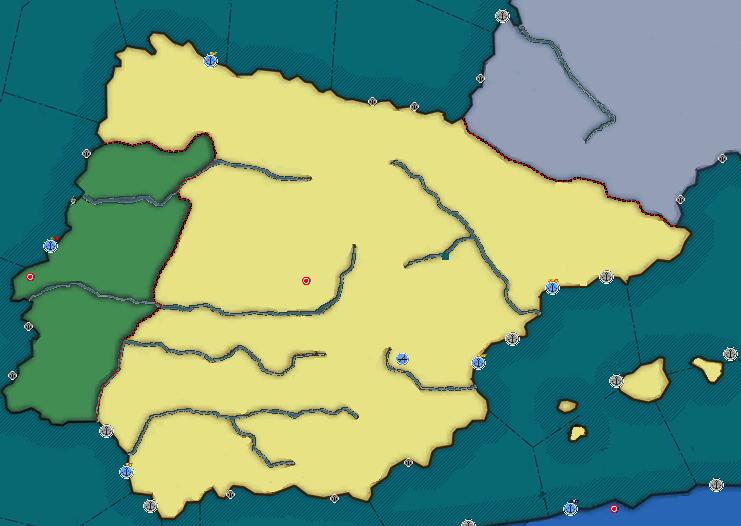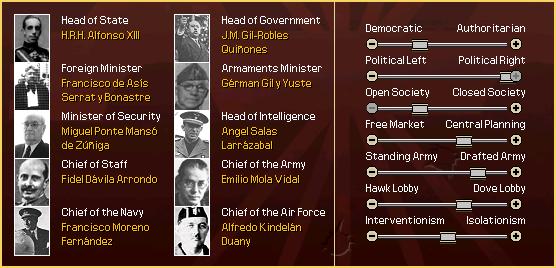Spain
From Kaiserreich
| ||||
| Motto Plus Ultra (Further Beyond) | ||||
| Anthem Marcha Real | ||||
| Official Language | Spanish | |||
| Capital | Madrid | |||
| Rey (King) | Alfonso XIII | |||
| Prime Minister | José María Gil-Robles y Quiñones | |||

| ||||
| Establishment (De Facto) - Union of the Crowns of Aragón and Castille | 1469 | |||
| Government | Constitutional monarchy | |||
| Currency | Peseta | |||
| Area | 504,030 km² | |||
| Population | circa 35,200,737 | |||
The Kingdom of Spain (Official Spanish:Reino de España short English form: Spain; Spanish short form: España) is a country in South West Europe. It borders Portugal to the west and the Commune of France to the north east. It also borders National France and Mittelafrika in Africa.
Contents |
History
Spanish confidence was badly shaken after the war against the United States of America which saw the empire lose her remaining colonies outside her immediate vicinity. Separatist movements in the Basque country and Catalonia gained support, the Church interfered in politics, and a radical workers movement destabilized the balance between conservatives and liberals. After taking the government in 1902, King Alfonso XIII showed expansionist tendencies, as demonstrated by the intervention in Morocco. The Algeciras Act of 1906 acknowledged Spanish interests in Morocco, and a protectorate over the North and South of the country was established in 1912, but it became a source of permanent unrest.
While Spain remained neutral throughout the Weltkrieg, 1918 saw social tensions erupt in a number of revolts by the rural populace, right wing factions and the increasingly powerful anarcho-syndicalist movement. Alfonso XIII supported the military coup against the government by General Miguel Primo de Rivera who abolished the constitution of 1876 and installed a dictatorial rule between 1923 and 1930. He ended the uprising in Morocco with a victory over Abd el-Krim in 1926, but could not master the economic crisis and had to resign after repeated revolts by the military and students. His position was taken over by José María Gil-Robles y Quiñones, a moderate right-wing politician.
Deep divisions remain within Spanish society in 1936; on one hand, the resurgent Carlist Movement, headed by Alfonso Carlos and Xavier de Borbón-Parma, aims to re-establish the "True Dynasty" and recreate an integralist Christian monarchy and on the other, the anarcho-syndicalist CNT-FAI has been inspired by the uprisings in both France and Britain to seek the abolition of the Spanish state altogether, and replace it with a voluntarist federation of communes and economic collectives.
Politics
Spain is ruled by a coalition of right-wing forces that supported king Alfonso's coup. However, he is not regarded as the true king by the Carlist movement which has been gaining support of some workers movements and of the very religious rural population. The Anarcho-Syndicalist alliance named C.N.T.-F.A.I. has polarized the left end of the political spectrum and has been repressed by the current administration. They have the support of most workers unions and have their 'revolutionary HQs' mainly based in urban areas.
King of Spain: H.R.H. Alfonso XIII
Presidents of the Council of Ministers: José María Gil-Robles y Quiñones
Minister for Foreign Affairs: Francisco de Asís Serrat y Bonastre
Minister of Economy and Finance: Gérman Gil y Yuste
Minister of the Interior: Miguel Ponte Mansó de Zúñiga
Head of Intelligence: José Ungría Jiménez
Minister of Defence: Fidel Dávila Arrondo
Captain General of the Spanish Army: José Sanjurjo Sacanell
Minister of the Navy: Francisco Moreno Fernández
Captain General of the Spanish Air Force: Ramón Franco Bahamonde
Military
The Spanish Armed Forces (Fuerzas Armadas Españolas) comprise many divisions, ships and aeroplanes. However, they are not completely loyal as some of their men have sympathies for the Anarco-Syndicalist movement and others even for the Carlist movement.
Army
The Spanish Army (Ejército de Tierra) comprise nineteen infantry division (with various brigades attached), with approximately a third of them protecting the border with the Commune of France. It also includes a specialized mountain infantry division, an old cavalry division and various colonial militias. There is even an incomplete armored division (Brigada Blindada), with some outdated light tanks from the last years of the Weltkrieg.
Navy
The Armada Española consists of two battleships, two heavy cruisers, five light cruisers, four destroyers, two submarines and four transport flotilla. However, some naval units are clearly outdated or in bad fighting shape.
Air Force
The Ejército del Aire consist of three interceptors, three tactical bombers and even two strategic bombers.
Foreign Relations
Very friendly relations with Portugal and Austria.
Friendly relations with Italian Federation, Germany, Canada and National France.
Unfriendly relations with Commune of France.
Colonial empire
Spanish colonial possession in Africa: Spanish Protectorate of Morocco and Spanish Territories of the Gulf of Guinea (also known as Spanish Guinea).



